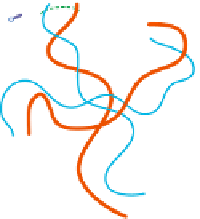Biomedical Engineering Reference
In-Depth Information
Basic medium
H
2
O
pH increase
pH decrease
Close to
neutrality
pH decrease
pH increase
H
2
O
Acidic medium
Structure and pH-sensitive swelling of a polysaccharide complex containing chitosan:
-
negative
charge of the anionic polymer; + positive charge of chitosan; --- ionic interaction;
▬
chitosan;
-
anionic polymer. Adapted with permission from Berger et al.(
2004a
) © 2004 Elsevier.
Figure 11.2
positively and negatively charged species sequentially or in
'
'fixing'
'
the PEC by adding
chemical or other non-covalent interactions.
Of course the number of positively charged, biocompatible polymers is quite limited,
but here chitosan (
Chapter 5
) has proved of major interest, and, as we will see below,
chitosan complexes have been suggested for a wide range of biomedical applications.
The number of anionic polymers is less limited, and the most commonly used include
alginates, pectins and xanthans (also introduced in
Chapter 5
). More recently there has
been renewed interest in exploiting the sulphated glycosoaminoglycans (GAGs, some-
times referred to as mucopolysaccharides) hyaluronic acid and chondroitin sulphate.
Proteins such as collagen and its derivative gelatin, synthetic polymers such as PAA, and
even DNA have also been investigated. A list of polyelectrolytes forming complexes
with chitosan is given by Berger et al.(
2004a
).









































































































































































Search WWH ::

Custom Search